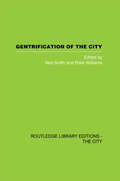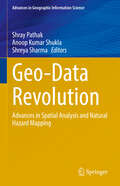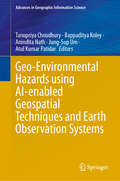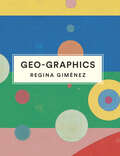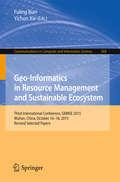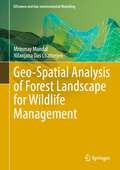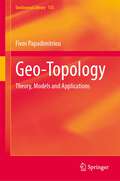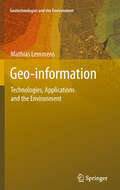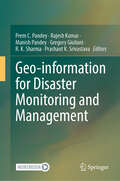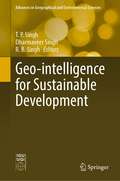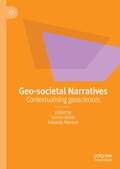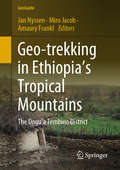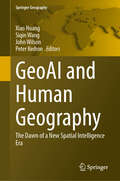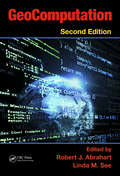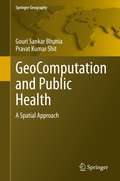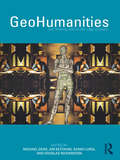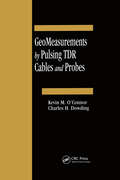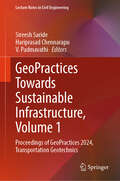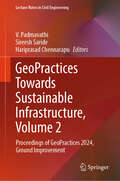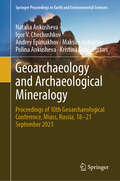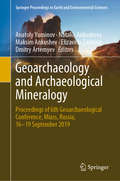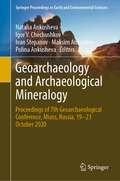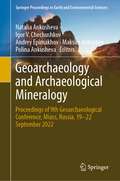- Table View
- List View
Geo-Data Revolution: Advances in Spatial Analysis and Natural Hazard Mapping (Advances in Geographic Information Science)
by Anoop Kumar Shukla Shray Pathak Shreya SharmaThis book offers a comprehensive guide to the geo-data revolution, emphasizing how cutting-edge advancements in spatial analysis and natural hazard mapping are transforming global industries and enhancing environmental monitoring. It explores real-world applications across various sectors such as urban planning, disaster management, agriculture, and more. Key topics include the rapid evolution of geo-data collection technologies and advanced spatial analysis tools, highlighting their pivotal role in improving our understanding of Earth’s environmental processes. Practical case studies showcase how geo-data is applied to tackle real-world challenges, from mapping natural hazards to optimizing infrastructure planning and advancing environmental conservation. Designed for geospatial professionals, researchers, policymakers, and students, the book provides both technical foundations and insights into the future of spatial technologies. With practical applications, this book will equip readers with the knowledge needed to harness geo-data for sustainable development, disaster resilience, and environmental protection. It can help communities worldwide expand their knowledge in disaster mapping, management, and mitigation.
Geo-Environmental Hazards using AI-enabled Geospatial Techniques and Earth Observation Systems (Advances in Geographic Information Science)
by Jung-Sup Um Tanupriya Choudhury Bappaditya Koley Anindita Nath Atul Kumar PatidarThis edited collection provides a comprehensive exploration of cutting-edge ideas, approaches, simulations, evaluations of risk, and systems that enhance the practicality of current geospatial technologies for reducing hazard risks. The various sections within this book delve into subjects such as the foundational principles of Earth Observation Systems (EOS) and geospatial methodologies. Additionally, the text serves as an advisory resource on the collaborative use of satellite-derived data and artificial intelligence to track and alleviate geo-environmental threats. The volume imparts extensive understanding regarding geo-environmental dangers and their analysis via EOS along with geospatial strategies. It encompasses key hazard-related themes including coastal degradation, predisposition to landslides, mapping vegetation coverages, tropical storm patterns, soil depletion due to erosion processes, vulnerability to rapid or extended flooding events, variations in oceansurface temperatures alongside chlorophyll-a levels; it also addresses assessments related to groundwater reserves and quality measures as well as sustainable management practices for watersheds that support community livelihoods—all through leveraging AI-integrated geospatial tools in conjunction with earth observation technologies. Furthermore, this work engages in discourse about systems designed for mitigating these ecological challenges sustainably. Scholars engaged in research activities; educational professionals; those involved in landscape design; engineers working at ground level; individuals responsible for policy-making—all who are concerned with geo-environmental hazards or associated domains—will find valuable insights within these pages.
Geo-Graphics
by Regina GiménezOur universe is brimming with secrets, and surprising curiosities. Here readers will learn the answers to all the questions they've asked themselves:What does the Sun look like from different planets in our galaxy? Why doesn't the Moon always appear the same? What is the largest river on Earth? And the highest mountain?In Geo-Graphics, our world becomes transformed by acclaimed artist Regina Giménez, into 96 pages of gorgeous shapes and colors. Planets and stars, continents and islands, rivers and lakes, volcanos and hurricanes … here they are presented as circles, polygons, lines, spirals, and accompanying facts that explain the world around us.This special and unusual atlas is a marriage of science and art like no other.
Geo-Informatics in Resource Management and Sustainable Ecosystem: Third International Conference, GRMSE 2015, Wuhan, China, October 16-18, 2015, Revised Selected Papers (Communications in Computer and Information Science #569)
by Fuling Bian Yichun XieThis volume constitutes the refereed proceedings of the Third International Conference on Geo-Informatics in Resource Management and Sustainable Ecosystem, GRMSE 2015, held in Wuhan, China, in October 2015.The 101 papers presented were carefully reviewed and selected from 321 submissions. The papers are divided into topical sections on Smart City in Resource Management and Sustainable Ecosystem; Spatial Data Acquisition Through RS and GIS in Resource Management and Sustainable Ecosystem; Ecological and Environmental Data Processing and Management; Advanced Geospatial Model and Analysis for Understanding Ecological and Environmental Process; Applications of Geo-Informatics in Resource Management and Sustainable Ecosystem.
Geo-Spatial Analysis of Forest Landscape for Wildlife Management (GIScience and Geo-environmental Modelling)
by Nilanjana Das Chatterjee Mrinmay MandalThis book presents research on landscape ecology and the relationship between humans and wildlife. It helps readers understand how ecological patterns and processes are interconnected. This research illustrates and proposes (practicable) management strategies toward long-term ecological restoration and mitigation of consequences of conflict. Increasing wildlife activities in localities and forest fringes are an alarming issue. Ecological processes like movement, colonization, extinction and conflict issues depend on the landscape and ecological activities, the movement for example of migratory elephants and their colonization not only affects society but the wildlife and biodiversity too. Strategic management measures can contribute to enriching the biodiversity, habitat quality as well as landscape, while minimizing human-wildlife conflicts. This book describes landscape ecological patterns and processes, habitat dominancy, habitat dependency, suitability, connectivity and corridor selection. To synthesize these patterns and processes, several ecological indices are used. Use of geo-spatial techniques improves future management strategies for similar circumstances, especially, related to forest regeneration and forest restoration. This book provides a concise overview to a wide range of readers including postgraduate students, researcher, academics, landscape planners, decision makers and even local populations. The techniques and management strategies described should help planners to improve forest management, by implementing quality enhancement programs such as plantation area selection and corridor selection.
Geo-Sustainnovation for Resilient Society: Select Proceedings of CREST 2023 (Lecture Notes in Civil Engineering #446)
by Hemanta Hazarika Stuart Kenneth Haigh Babloo Chaudhary Masanori Murai Suman ManandharThis book presents select proceedings of the 2nd International Conference on Construction Resources for Environmentally Sustainable Technologies (CREST 2023), and focuses on sustainability, promotion of new ideas and innovations in design, construction and maintenance of geotechnical structures with the aim of contributing towards climate change adaptation and disaster resiliency to meet the UN Sustainable Development Goals (SDGs). It presents latest research, information, technological advancement, practical challenges encountered, and solutions adopted in the field of geotechnical engineering for sustainable infrastructure towards climate change adaptation. This volume will be of interest to those in academia and industry alike.
Geo-Topology: Theory, Models and Applications (GeoJournal Library #133)
by Fivos PapadimitrouGeo-Topology is an exploration of the depth and breadth of the relationships between Geography and Topology, with applications ranging from Landscape Geography to Social Geography and from Spatial Analysis to Geospatial Technologies. It shows how topics of geographical research (landscapes, borders, spatial social relationships etc) can be examined by using mathematical concepts and methods of Topology, exposing the realm of geo-topological modelling and visualization through Point-Set Topology, Knot Theory, Reeb graphs, Topological Surfaces (i.e. Möbius bands and Klein bottles), Differential Topology, Network Analysis, Combinatorial Topology, Braid Theory and Ultrametric Topology. Besides geographers, this book is a trove of new ideas for landscape ecologists, mathematicians, data scientists, sociologists, psychologists, anthropologists and educators. Geo-Topology is a systematic introduction to topological thinking in Geography, also by highlighting the significance of Topology for Geographical Education, as well as for the Philosophy and Epistemology of Geography.
Geo-information
by Mathias LemmensGeomatics, the handling and processing of information and data about the Earth, is one geoscience discipline that has seen major changes in the last decade, as mapping and observation systems become ever more sensitive and sophisticated. This book is a unique and in-depth survey of the field, which has a central role to play in tackling a host of environmental issues faced by society. Covering all three strands of geomatics - applications, information technology and surveying - the chapters cover the history and background of the subject, the technology employed both to collect and disseminate data, and the varied applications to which geomatics can be put, including urban planning, assessment of biodiversity, disaster management and land administration. Relevant professionals, as well as students in a variety of disciplines such as geography and surveying, will find this book required reading. This rapidly developing field uses increasingly complex and accurate systems. Today, technology enables us to capture geo-data in full 3D as well as to disseminate it via the Web at the speed of light. We are able to continuously image the world from space at resolutions of up to 50 cm. Airborne LiDAR (laser surveying) sensors can be combined with digital camera technology to produce geometrically correct images of the Earth's surface, while integrating these with large-scale topographic maps and terrestrial as well as aerial images to produce 3D cityscapes that computer users can explore from their desktops.
Geo-information for Disaster Monitoring and Management
by Prashant K. Srivastava R. K. Sharma Rajesh Kumar Prem C. Pandey Manish Pandey Gregory GiulianiThe objective of this publication is to provide insight into advancing remote sensing techniques dealing with floods, droughts, landslides, earthquakes, permafrost-related hazards, glacial lake outburst floods, forest fires, droughts, tropical cyclones, climate resilience and COVID-19. This publication will incorporate the latest technologies and techniques to illustrate disaster monitoring for acquiring information and dissemination of technological results and outcomes for the betterment of society. This publication would be of immense importance for earth scientists, policymakers and professionals working in the field of disaster risk reduction.
Geo-intelligence for Sustainable Development (Advances in Geographical and Environmental Sciences)
by R. B. Singh T. P. Singh Dharmaveer SinghGlobally, concerns for the environment and human well-being have increased as results of threats imposed by climate change and disasters, environmental degradation, pollution of natural resources, water scarcity and proliferation of slums. Finding appropriate solutions to these threats and challenges is not simple, as these are generally complex and require state-of-the-art technology to collect, measure, handle and analyse large volumes of varying data sets. However, the recent advances in sensor technology, coupled with the rapid development of computational power, have greatly enhanced our abilities to capture, store and analyse the surrounding physical environment. This book explores diverse dimensions of geo-intelligence (GI) technology in developing a computing framework for location-based, data-integrating earth observation and predictive modelling to address these issues at all levels and scales. The book provides insight into the applications of GI technology in several fields of spatial and social sciences and attempts to bridge the gap between them.
Geo-societal Narratives: Contextualising geosciences
by Martin Bohle Eduardo MaroneThis book provides an accessible overview of the societal relevance of contemporary geosciences. Engaging various disciplines from humanities and social sciences, the book offers philosophical, cultural, economic, and geoscientific insights into how to contextualise geosciences in the node of Culture and Nature.The authors introduce two perspectives of societal geosciences, both informed by the lens of geoethics. Throughout the text core themes are explored; human agency, the integrity of place, geo-centricity, economy and climate justice, subjective sense-making and spirituality, nationalism, participatory empowerment and leadership in times of anthropogenic global change. The book concludes with a discussion on culture, education, or philosophy of science as aggregating concepts of seemingly disjunct narratives.The diverse intellectual homes of the authors offer a rich resource in terms of how they perceive human agency within the Earth system. Two geoscientific perspectives and fourteen narratives from various cultural, social and political viewpoints contextualise geosciences in the World(s) of the Anthropocene.
Geo-trekking in Ethiopia’s Tropical Mountains: The Dogu’a Tembien District (GeoGuide)
by Jan Nyssen Miro Jacob Amaury FranklThis book is based on over 150 scientific papers about the Dogu’a Tembien district in Ethiopia. To reach a broader public of people interested in geosites and human-environment interactions, the authors here add a geoguide about this mountain district in Ethiopia(13°30’ N, 39°10’ E; upto 2850 m high) which shows a varied lithology. A large team has carried out research in that district over the past 23 years, including long stays in the areas. Numerous viewpoints and geosites are only accessible on foot; hence the authors prepared the book as a trekking guide, which will enhance sustainable tourism in the same time. This edited work summarises the study results in the international literature into a comprehensive book, which comprises 35 thematic chapters, detailed description of 573 km of trekking routes to access the landscape and the most scenic excursion points, as well as the necessary logistical information. A state-of-the-art trekking map is included as a digital annex.
GeoAI and Human Geography: The Dawn of a New Spatial Intelligence Era (Springer Geography)
by John Wilson Xiao Huang Siqin Wang Peter KedronThis volume outlines a comprehensive journey into how geospatial artificial intelligence (GeoAI) is reshaping our understanding of people and places. Merging traditional geographic inquiry with AI technologies, it offers a holistic view of digital tools and advanced algorithms that redefine human geography. Across twenty‐eight chapters, the book chronicles the evolution of geographic thought into the GeoAI era. Innovative methodologies—from explainable spatial analysis and natural language processing to human-centered computer vision and high-performance computing—reveal new patterns and relationships beyond conventional approaches. Each contribution highlights both technical strides in data processing and enriched perspectives on cultural, economic, political, health, and urban studies. Showcasing diverse applications in disaster management, climate change adaptation, and urban planning, the volume demonstrates GeoAI&’s transformative potential. It also engages with ethical, sustainable, and social challenges, emphasizing that technological innovation must serve real-world impacts and inclusivity. Ideal for researchers, students, and practitioners alike, this volume invites you to explore new frontiers at the intersection of technology and human experience.
GeoComputation
by Robert J. Abrahart Linda SeeA revision of Openshaw and Abrahart's seminal work, GeoComputation, Second Edition retains influences of its originators while also providing updated, state-of-the-art information on changes in the computational environment. In keeping with the field's development, this new edition takes a broader view and provides comprehensive coverage across the
GeoComputation and Public Health: A Spatial Approach (Springer Geography)
by Gouri Sankar Bhunia Pravat Kumar ShitGeoComputation and Public Health is fundamentally a multi-disciplinary book, which presents an overview and case studies to exemplify numerous methods and solicitations in addressing vectors borne diseases (e.g, Visceral leishmaniasis, Malaria, Filaria). This book includes a practical coverage of the use of spatial analysis techniques in vector-borne disease using open source software solutions. Environmental factors (relief characters, climatology, ecology, vegetation, water bodies etc.) and socio-economic issues (housing type & pattern, education level, economic status, income level, domestics’ animals, census data, etc) are investigated at micro -level and large scale in addressing the various vector-borne disease. This book will also generate a framework for interdisciplinary discussion, latest innovations, and discoveries on public health. The first section of the book highlights the basic and principal aspects of advanced computational practices. Other sections of the book contain geo-simulation, agent-based modeling, spatio-temporal analysis, geospatial data mining, various geocomputational applications, accuracy and uncertainty of geospatial models, applications in environmental, ecological, and biological modeling and analysis in public health research. This book will be useful to the postgraduate students of geography, remote sensing, ecology, environmental sciences and research scholars, along with health professionals looking to solve grand challenges and management on public health.
GeoHumanities: Art, History, Text at the Edge of Place
by Douglas Richardson Michael Dear Jim Ketchum Sarah LuriaIn the past decade, there has been a convergence of transdisciplinary thought characterized by geography’s engagement with the humanities, and the humanities’ integration of place and the tools of geography into its studies. GeoHumanities maps this emerging intellectual terrain with thirty cutting edge contributions from internationally renowned scholars, architects, artists, activists, and scientists. This book explores the humanities’ rapidly expanding engagement with geography, and the multi-methodological inquiries that analyze the meanings of place, and then reconstructs those meanings to provoke new knowledge as well as the possibility of altered political practices. It is no coincidence that the geohumanities are forcefully emerging at a time of immense intellectual and social change. This book focuses on a range of topics to address urgent contemporary imperatives, such as the link between creativity and place; altered practices of spatial literacy; the increasing complexity of visual representation in art, culture, and science and the ubiquitous presence of geospatial technologies in the Information Age. GeoHumanties is essential reading for students wishing to understand the intellectual trends and forces driving scholarship and research at the intersections of geography and the humanities disciplines. These trends hold far-reaching implications for future work in these disciplines, and for understanding the changes gripping our societies and our globalizing world.
GeoMeasurements by Pulsing TDR Cables and Probes
by Kevin M O'Connor Charles H DowdingGeoMeasurements by Pulsing TDR Cables and Probes examines Time Domain Reflectometry (TDR) research and provides information on its use as a robust, reliable, and economical production tool.Common uses for TDR technology include telecommunications and power industries, but the text examines applications such as measurement of moisture of unsaturated soils; detection of fluids for leak and pollution; measurement of water levels for hydrological purposes; measurement of water pressures beneath dams; and deformation and stability monitoring of mines, slopes, and structures.Chapters discuss:basic physics of signal generation, transmission, and attenuation along the coaxial cableprobe designs and procedures for calibration as well as the variation in probe responses to changes in water content and soil mineralogyvariations in waveform characteristics associated with cable, deformation, cable calibration, and installation techniques for metallic cables in rockseveral cases demonstrating the use of TDR cables in soil as well as weathered and soft rocka rationale for the use of compliant cable in soilthe use of metallic cable (MTDR) and optical fiber (OTDR) to monitor response of structuressensor/transducer components, connections from the sensors to the TDR pulser/sampler, and system control methodsavailable software for transmission and analysis of TDR signatures The diverse interest and terminology within the TDR community tends to obscure commonalities and the universal physical principles underlying the technology. The authors seek to crystallize the basic principles among the seemingly divergent specialties using TDR technology in geomaterials. By examining varied experiences, GeoMeasurements by Pulsing TDR Cables and Probes provides a synergistic text necessary to unify the field.
GeoPractices Towards Sustainable Infrastructure, Volume 1: Proceedings of GeoPractices 2024, Transportation Geotechnics (Lecture Notes in Civil Engineering #589)
by Sireesh Saride Hariprasad Chennarapu V. PadmavathiThis book discusses the proceedings of the National Conference on GeoPractices for Sustainable Infrastructure (GeoPractices 2024), focusing on the sustainable aspects of geotechnical engineering practices, particularly in highway construction and related ground improvement techniques. It covers topics such as alternative and sustainable construction materials, processes, and design considerations for pavement construction and enhancing weak soils. The publication highlights advanced practices and developments, including the use of geosynthetics, bioremediation, and incorporating industrial byproducts to lower carbon footprint, preserve natural resources, and minimize waste generation. The book is intended to be a valuable resource for emerging researchers and industry professionals interested in advancing sustainable infrastructure.
GeoPractices Towards Sustainable Infrastructure, Volume 2: Proceedings of GeoPractices 2024, Ground Improvement (Lecture Notes in Civil Engineering #592)
by Sireesh Saride Hariprasad Chennarapu V. PadmavathiThis book discusses the proceedings of the National Conference on GeoPractices for Sustainable Infrastructure (GeoPractices 2024), focusing on the sustainable aspects of geotechnical engineering practices, particularly in highway construction and related ground improvement techniques. It covers topics such as alternative and sustainable construction materials, processes, and design considerations for pavement construction and enhancing weak soils. The publication highlights advanced practices and developments, including the use of geosynthetics, bioremediation, and incorporating industrial byproducts to lower carbon footprint, preserve natural resources, and minimize waste generation. The book is intended to be a valuable resource for emerging researchers and industry professionals interested in advancing sustainable infrastructure.
Geoarchaeology and Archaeological Mineralogy: Proceedings of 10th Geoarchaeological Conference, Miass, Russia, 18–21 September 2023 (Springer Proceedings in Earth and Environmental Sciences)
by Natalia Ankusheva Maksim Ankushev Igor V. Chechushkov Polina Ankusheva Andrey V. Epimakhov Kristina ŠarićThe volume of Springer Proceedings in Geoarchaeology and Archaeological Mineralogy contains selected papers presented at the 10th Geoarchaeology Conference, which took place during September 18–21, 2023, at the South Urals Federal Research Center, the Ural Branch of the Russian Academy of Sciences, Miass, Russia. The Proceedings unite studies in the fields of archaeometry, geoarchaeology, and ancient technologies, based on cases from northern Eurasia, and include archaeometallurgy, stone tools investigation, exploitation of geological resources in the past, bioarchaeology, residue analysis, pottery and lithics investigation, use of the GIS in archaeology. A study of non-organic materials, rocks, minerals, ores, metals, metallurgical slags is a special focus of the book. Many papers also use modern analytical methods of isotopic, chemical, and mineralogical analysis to study the composition and structure of ancient materials and the technological practices of past human populations of Modern Russia, Caucasus, and Serbia. The volume is intended for archaeologists, historians, museum staff, and geologists, as well as students, researchers from other disciplines, and the general public interested in the interdisciplinary research in the field of archaeology and archaeological materials, strategies and techniques of past quarrying, mining, metallurgy and lithic technologies at different chronological periods in Northern Eurasia.
Geoarchaeology and Archaeological Mineralogy: Proceedings of 6th Geoarchaeological Conference, Miass, Russia, 16-19 September 2019 (Springer Proceedings In Earth And Environmental Sciences)
by Anatoly Yuminov Natalia Ankusheva Maksim Ankushev Elizaveta Zaykova Dmitry ArtemyevThis book presents general problems in geoarchaeology, and discusses geophysical solutions, X-ray fluorescence spectrometry applications, X-ray and isotope analyses and GIS technologies. It also examines practical reconstructions of technological processes used in ancient time, and investigates the use of minerals and rocks by ancient societies in the territories of modern Russia, Ukraine, Turkmenistan, and Tajikistan, as well as the characteristics of ores, metallurgical slags and data on the composition and impurities of archaeological metals. Intended for archaeologists, historians, museum workers and geologists studying noble metals and copper, the book is also a useful resource for students, graduate students, experts and anyone interested in the use of various minerals at different stages of humanity’s development.
Geoarchaeology and Archaeological Mineralogy: Proceedings of 6th Geoarchaeological Conference, Miass, Russia, 16–19 September 2019 (Springer Proceedings in Earth and Environmental Sciences)
by Anatoly Yuminov Natalia Ankusheva Maksim Ankushev Elizaveta Zaykova Dmitry ArtemyevThis book presents general problems in geoarchaeology, and discusses geophysical solutions, X-ray fluorescence spectrometry applications, X-ray and isotope analyses and GIS technologies. It also examines practical reconstructions of technological processes used in ancient time, and investigates the use of minerals and rocks by ancient societies in the territories of modern Russia, Ukraine, Turkmenistan, and Tajikistan, as well as the characteristics of ores, metallurgical slags and data on the composition and impurities of archaeological metals. Intended for archaeologists, historians, museum workers and geologists studying noble metals and copper, the book is also a useful resource for students, graduate students, experts and anyone interested in the use of various minerals at different stages of humanity’s development.
Geoarchaeology and Archaeological Mineralogy: Proceedings of 7th Geoarchaeological Conference, Miass, Russia, 19–23 October 2020 (Springer Proceedings in Earth and Environmental Sciences)
by Natalia Ankusheva Maksim Ankushev Igor V. Chechushkov Ivan Stepanov Polina AnkushevaThis book of Springer Proceedings in Geoarchaeology and Archaeological Mineralogy contains selected papers presented at the 7th Geoarchaeology Conference, which took place during October 19–23, 2020, at the South Urals Federal Research Center, Ural Branch of Russian Academy of Sciences, Miass, Russia. The Proceedings combine studies in archeometry, geoarchaeology, and ancient North Eurasian technologies, including paleometallurgy, stone tools investigation, past exploitation of geological resources, bioarchaeology, residue analysis, pottery, and lithics studies. This book also specializes in various non-organic materials, rocks, minerals, ores, and metals, especially copper and metallurgical slags. Many types of research also use modern analytical methods of isotopic, chemical, and mineralogical analysis to address the composition and structure of ancient materials and the technological practices of past human populations of modern Russia, Ukraine, Turkmenistan, Tajikistan, and Mongolia. This book is intended for archaeologists, historians, museum workers, and geologists, as well as students, researchers from other disciplines, and the general public interested in the interdisciplinary research in the field of archaeology and archaeological materials, strategies and techniques of past quarrying, mining, metallurgy and lithic technologies at different chronological periods in Eurasian steppe and adjacent forest zone.
Geoarchaeology and Archaeological Mineralogy: Proceedings of 9th Geoarchaeological Conference, Miass, Russia, 19–22 September 2022 (Springer Proceedings in Earth and Environmental Sciences)
by Natalia Ankusheva Maksim Ankushev Igor V. Chechushkov Polina Ankusheva Andrey EpimakhovThe volume of Springer Proceedings in Geoarchaeology and Archaeological Mineralogy contains selected papers presented at the 9th Geoarchaeology Conference, which took place during September 19–22, 2022, at the South Urals Federal Research Center, the Ural Branch of the Russian Academy of Sciences, Miass, Russia. The Proceedings unite studies in the fields of archeometry, geoarchaeology, and ancient technologies, based on cases from northern Eurasia, and include archaeometallurgy, stone tools investigation, exploitation of geological resources in the past, bioarchaeology, residue analysis, pottery and lithics investigation, use of the GIS in archaeology. A study of non-organic materials, rocks, minerals, ores, metals, metallurgical slags is a special focus of the book. Many papers also use modern analytical methods of isotopic, chemical, and mineralogical analysis to study the composition and structure of ancient materials and the technological practices of past human populations of Modern Russia, Ukraine, Turkmenistan, Tajikistan, and Mongolia. The volume is intended for archaeologists, historians, museum workers, and geologists, as well as students, researchers from other disciplines, and the general public interested in the interdisciplinary research in the field of archaeology and archaeological materials, strategies and techniques of past quarrying, mining, metallurgy and lithic technologies at different chronological periods in Eurasian steppe and adjacent forest zone.
